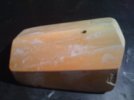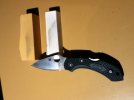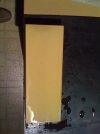Jason knows the most but here's what I use mine for.
First off I have a synthetic Nagura that came with an Ice Bear 10,000 stone. I never have used it other than to try it out. I never use the 10,000 stone but that's a whole other post.
BUT
I have this natural Nagura stone shown below. I bought it out of a bucket at a WoodCraft store and I just use it ALLLLLLLLLLLL the time. They seem to have disappeared from the market and it really concerns me that I may have trouble getting another one if I use this one up.
I use the natural Nagura to clean my stones ONLY. I never use it to make a slurry for sharpening. I have no use for a slurry on the Norton and Shapton Pro stones and the Shapton Glass stones that I sharpen on. I want the stone clean . . . clean of metal in the pores but also clean of any rolly polly gritty stuff that is going to slow down and literally impede the sharpening performance of my stones. Now I have tried all that slurry nonsense and it is a waste of time at least for the stones I use. Grit anchored in a stone matrix or even glued on a sheet of paper (sand paper) is DEFINITELY going to do more for me and do it faster than the same grit loose and acting like little ball bearings between my edge tool and the flat surface I am working against.
Period.
So yeah . . . no slurry . . . nasty stuff . . . I wash it off as soon as it builds up much at all.
If I were to attempt to sharpen and polish all on one or two stones I might sing a different tune and let the grit kind of pulverize and act as a finer stone toward the end of the process but thank Bob I have a whole progression of stones to choose from and so I work the list and get the mirror like results and quick like a bunny the apex cuts like magic.
So how do I use the natural Nagura ?
See in the second photo those little stones (they look like synthetic nagura but they are actually pieces of Norton water stone) the white stone is 4,000 Norton water stone and the yellow one is 8,000 Norton water stone. See the metal in the pores from touching up the ZDP-189 Dragonfly ?
I would wet the natural Nagura under the kitchen faucet, rub a flat portion of the Nagura fairly lightly on the stone until I got a slurry, rub the slurry around and around with my fingers on the stone until the metal was lifted our of the pores of the stone, kind of like an eraser does with pencil marks on paper and then while continuing to rub with my fingers I would rinse the slurry off under the kitchen faucet using cool water. Warm or hot water can cause the water stones to build up stress and chip or I suppose they could even crack if one went from a cold bucket of soaking water to very hot water under the faucet.
Once the slurry is rinsed off I am ready for more sharpening. I do this more than once while sharpening the same edge to keep the pores clean and between sharpening different edge tools. I flatten when I need to flatten. I don't need to flatten all the time to clean the stones.
I do not see much in the way of degradation of my flat stones from using this fairly soft natural Nagura. It is a mute point.
Depending on what I am sharpening that will dictate how flat I need the stones to be. Knives no big deal but the backs of chisels and hand tool wood working plane blades then I want the stones particularly flat and for what is called "finish" plane blades I want the stones the flattest .
With my large Norton water stones I have one side that is kept dead flat for when I need that and the other side of the stone will be allowed to get a little more out of flat but we are still taking ten thousandths of an inch out of flat . . . in other words BOTH sides are very flat it is just that one side is particularly flat on each stone.
So I don' know anything about Japanese natural water stones but that is how I use the natural nagura on the man made water stones from Norton and Shapton.


Here is the Norton full size 8,000 stone after being cleaned with the natural Nagura.




